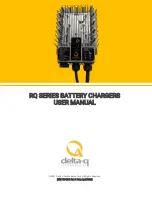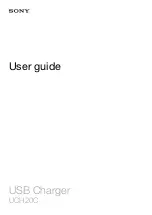
Duo Charge Operation
When the four required wires are connected to the Duo Charge, a start-up sequence will initiate on the Duo Charge’s six
color-coded LED display. When powered up, the LEDs will:
Illuminate from right to left (amber to green) four times, indicating that the Duo Charge is set for 12-volt operation.
1.
Illuminate the #1 and #2 amber LEDs, followed by a green LED,
2.
indicating battery program type. The #3 green indicates Stan-
dard Flooded; the #4 green indicates Deep Cycle Flooded; the
#5 green indicates gel; and the #6 green indicates AGM.
Illuminate the #1 amber, followed by a combination of green
3.
LEDs, indicating low voltage activation. See the Balmar Duo
Charge web page for detailed values for low and high voltage
settings.
Illuminate the #2 amber, followed by a combination of green
4.
LEDs, indicating maximum voltage ouput.
Illuminate the #3 green LED, indicating that the Duo Charge is
5.
in operation.
If, upon start up, the Duo Charge display deviates from the sequence
above, or if the #3 LED begins to blink, proceed to the troubleshoot-
ing instructions.
The Duo Charge performs like a DC to DC battery charger. When
the Duo Charge recognizes 13 volt or greater on the input terminal
the Duo Charge will turn on and start passing current to the start
battery.
The maximum output amperage of the Duo Charge is 30 amps and
if the demand is
greater than 30 amps the Duo Charge will go into an over current
condition, shut down and
try again. During the over current condition the Duo Charge will
not put out any amperage. So, if you
decided to install the Duo Charge to charge a bow thruster battery,
windlass battery or a battery that can be highly
discharged the Duo Charge may go into the over current condition because the demand is greater than 30 amps.
When used as a stand alone charge source, the Duo Charge is designed to discontinue charging when demands exceed its
capabilities. At that point, the Duo Charge will wait for a short period and query if the demand has diminished to below its
30-amp capacity. If so, the Duo Charge will continue charging. If demand continues to exceed capacity, the Duo Charge will
continue to shut down, while checking periodically to see if demand has diminished.
If your application requires frequent charging levels in excess of 30 amps, it may be necessary to add a solenoid as a meth-
od to manually bypass the Duo Charge’s internal circuitry. Keep in mind, the Duo Charge will not automatically activate
the solenoid if the demand exceeds its capacity. As such, it is important to monitor charging voltage closely at the battery
being charged by the Duo Charge.
To utilize the Duo Charge’s solenoid drive function, it will be necessary for the user to supply an appropriate-capacity sole-
noid and a toggle or other ON/OFF switching mechanism to control the bypass function.
5
NOTES:


























